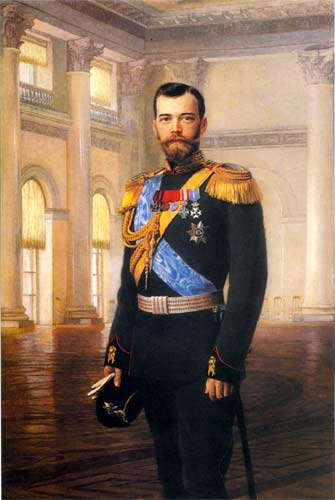
Nicholas II (1894-1917)
 |
Although Empress Dowager Maria wanted to have Grand Duke Michael, her second son, to become the tsar, the irrevocable law demanded the crown to pass to the eldest son, Nicholas (born on May 6, 1868), who ascended the throne after the death of his father on October 20, 1894. Alexander III was only in his grave a week, when Nicholas’ wedding took place in St.Petersburg. He married the daughter of Grand Duke Ludwig of Hessen, Alice Victoria Eleanor Louisa Beatrice, who having converted into Russian Orthodoxy, was now known as Alexandra Fedorovna. She gave birth to five children - four daughters: Olga, Tatiana, Maria and Anastasia and the Tsarevich Alexei, who suffered from hemophilia and was a permanent invalid.The date happened to be on the Dowager Empress Maria’s birthday, so the relaxation of the mourning was allowed. |
Nicholas II, the last Russian Emperor, was crowned on May 14, 1896 and the ceremony in Moscow was overshadowed by a catastrophe on Khodynskoe Field, where more than a thousand spectators were crushed to death. In foreign policy, Nicholas II wanted to cover his reign with glory at all cost; the tsar had plans of conquering Manchuria, Korea, Tibet, Persia and Constantinople. Witte and Foreign Minister Lamsdorf tried to convince him not to make war on Japan, but the obstinate Nicholas did it. And it turned out to be a series of Russian defeats on land and sea, culminating in the destruction of the Baltic fleet in the Tsushima Strait. In 1904-1905 the country suffered a heavy defeat by Japan: 400,000 men were killed, wounded or captured, and material losses were valued at 2.5-billion gold rubles. The lost war whipped up public unrest. 100.000 people went on strike in St.Petersburg, and another 100.000 joined them the next day. The St. Petersburg workers, led by the priest Gapon, marched on the Winter Palace to present Emperor Nicholas with a loyal petition containing demands in favor of a popularly elected legislative assembly. They were conquering an eight-hour workday, wages above the sustenance level, social insurance, abolition of land redemption by peasants, and free compulsory general education. The petition was to be taken to the Tsar on Sunday, January 9, 1905, but the royal family was scared of industrial action and apprehended violent unrest – worker columns were met by troops who opened fire on them, and about 130 were killed – this massacre became known as Bloody Sunday. The royal family moved to Alexandrovsky Palace in Tsarskoye Selo immediately after Christmas, determined never to leave it. Pressurized by the public, Nicholas announced the convocation of parliament, the State Duma, on 19 August 1905. Stringent polling terms moved the country to more strikes, and Witte convinced the emperor to sign a manifesto granting freedoms of personality and assembly, and universal franchise, but freedoms accorded to people in this manifesto of October 17, 1905, were soon annulled. The lost Russian-Japanese War, the crush of democratic hopes, a disbanded parliament bred new quests in arts (Benois, Marc Shagal, Kazimir Malevich), literature (the so-called Silver Age of Russian literature - Symbolists, Futurists and Akmeists), architecture (romantic and exquisite art nouveau) and philosophy. In desire to commemorate his father, Nicholas signed a decree several months after his death to establish in St.Petersburg the Russian Museum named after Alexander III. During Nicholas II’s reign, Russia was involved in two wars. On August 1, 1914 the World War I broke out, which Russia entered on the Allied side and even greater losses were suffered. Loss of territory, shortage of food, massive casualties and confusion at home were the main reasons for the Second Russian Revolution in February 1917. On March 2, 1917, Nicholas II signed an abdicated manifesto and the royal family, used to remain in Tsarskoye Selo then, by decision of the interim government, was transported to Siberia. In April 1918, the Bolshevik government decided to move the Imperial family to Yekaterinburg in the Urals. Here, they were all shot on July 17, 1918. The bodies were hidden and have only recently been found and identified.
|
Copyright © 2004-2005 Palytra Travel
All rights reserved |
Website development |

